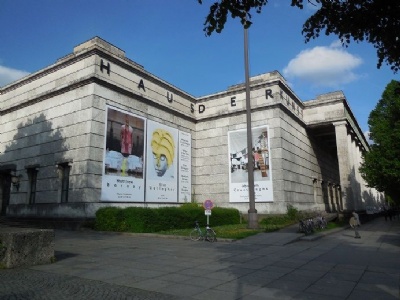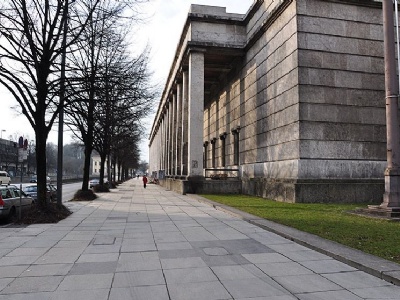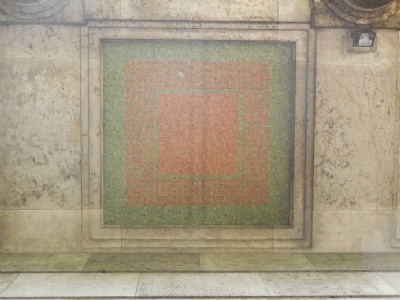München – Haus der Kunst
In October 1933, Hitler laid the foundation stone for the construction of a new and large art museum in Munich called Haus der kunst. The museum was designed by Hitler’s then favorite architect Paul Ludwig Troost and inaugurated in the summer of 1937 with an exhibition called Grosse Deutsche Kunstausstellung. Works by ”official” Nazi artists such as Adolf Wissel, Werner Painer and Conrad Hommel were exhibited. Haus der kunst was perhaps the first grand construction that the Nazis started and here Germany’s finest and noblest art would be shown to the public. The exterior of the museum is characterized by typical Nazi monumental architecture with a colonnade of large and sturdy gray pillars on the front.
Current status: Preserved with museum (1997).
Address: Prinzregentenstrasse 1, 80538 München.
Get there: Metro to Odeonsplatz Station.
Follow up in books: Rydell, Anders: The Book Thieves: The Nazi Looting of Europe’s Libraries and the Race to Return a Literary Inheritance (2017).




Between 1933 and 1945 the Nazis confiscated (stole) about 650,000 art objects, in particular Jewish properties. A large part of this art ended up in the private collections of the Nazis, while others were exhibited in museums/galleries or stored. At the end of the war, many art objects were destroyed in connection with battles and bombings. Some art objects Nazis transported to different locations (hideouts) to avoid being destroyed or found by the Allies. When the war ended, the stolen art objects that were left were scattered throughout Europe and it was extremely difficult to inventory what was left and where it was. Many rightful owners had been murdered by the Nazis and the heirs were often told that the art objects were missing. Another problem was that the art objects were usually considered stateless when the previous owner were dead or presumed dead.
But as the years went by, some art objects began to appear at auctions or similar where they were sold and bought in a belief that everything was in order. Therefore, it was extremely difficult for the heirs to claim the art objects because the ownership conditions were legally problematic. In addition, several heirs had already received symbolic compensation. Therefore, much of the art objects that the Nazis confiscated (stole) ended up in private collectors possessions or art museums around the world. The problem was that the buyers did not reflect on the origin of the art objects and whether the objects actually had the right to be sold.
As recently as 1998, 44 governments and 13 non-profit organizations gathered at the initiative of the U. S. Department of State and the United States Holocaust Museum in Washington to discuss guidelines on how stolen art objects should be treated and this resulted in something that came to be called the Washington Principles. This means that the current owners of the art objects are urged to compensate the rightful heirs in a reasonable way, either by returning the art objects or by means of a financial compensation. The principles are still not binding, but rather a call to find a solution where some countries have been more willingly to do the right thing than others.
In Sweden, this became relevant in 2003 when an American lawyer contacted the Modern museum in Stockholm regarding the painting, Blumengarten. This painting was painted in 1917 by the German impressionist and expressionist Emil Nolde (1867 – 1956). The painting was owned by the German Jewish businessman, Isaac Nathan Deutsch, who was forced to flee to Holland shortly before the outbreak of war. But the painting was left behind in Germany, at the moving company hired by Nathan Deutsch. Deutsch did not survive the war and when his heirs searched for the painting after the war, it was said that it had been destroyed during a bombing raid. In the early sixties, the heirs received a symbolic allowance, but in 1967 the painting appeared in an art gallery in Switzerland and was bought (in good faith) by Modern museum, Stockholm. On behalf of the government, in 2009 the museum was urged to come to an agreement with the heirs and the painting was sold to a private collector. The agreement included that the museum was allowed to keep the painting til 2014. This is the only occasion where the Washington principles has been practiced in Sweden.